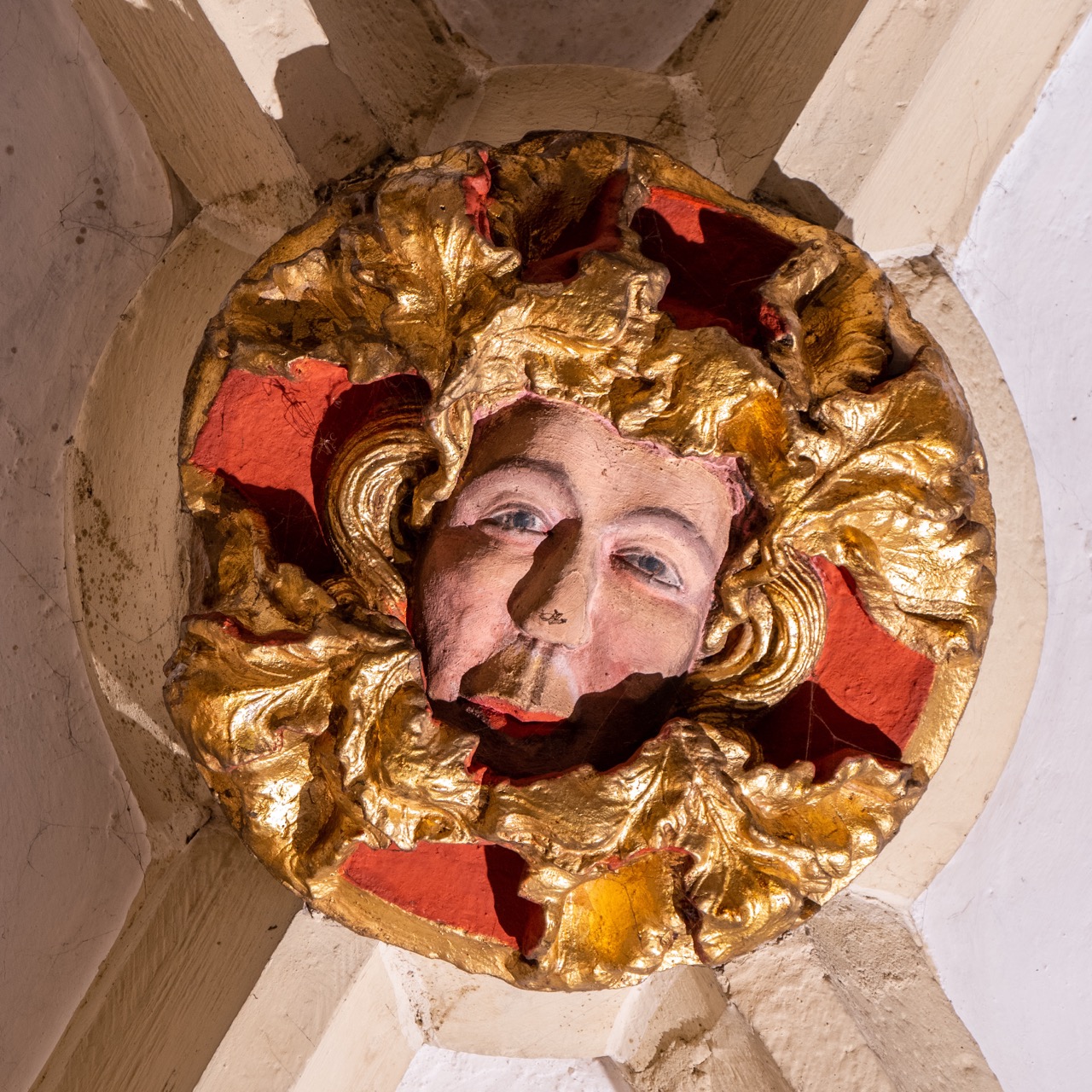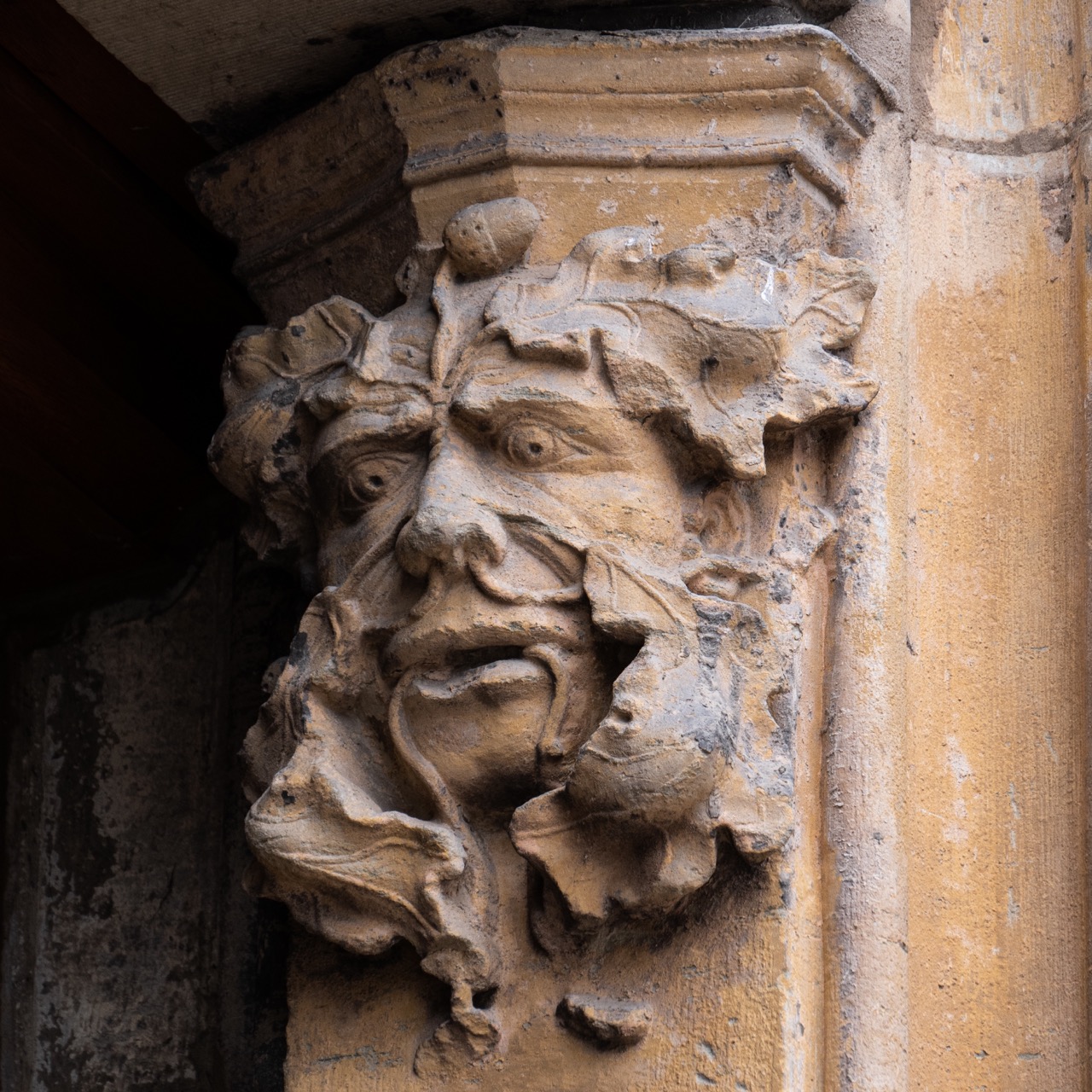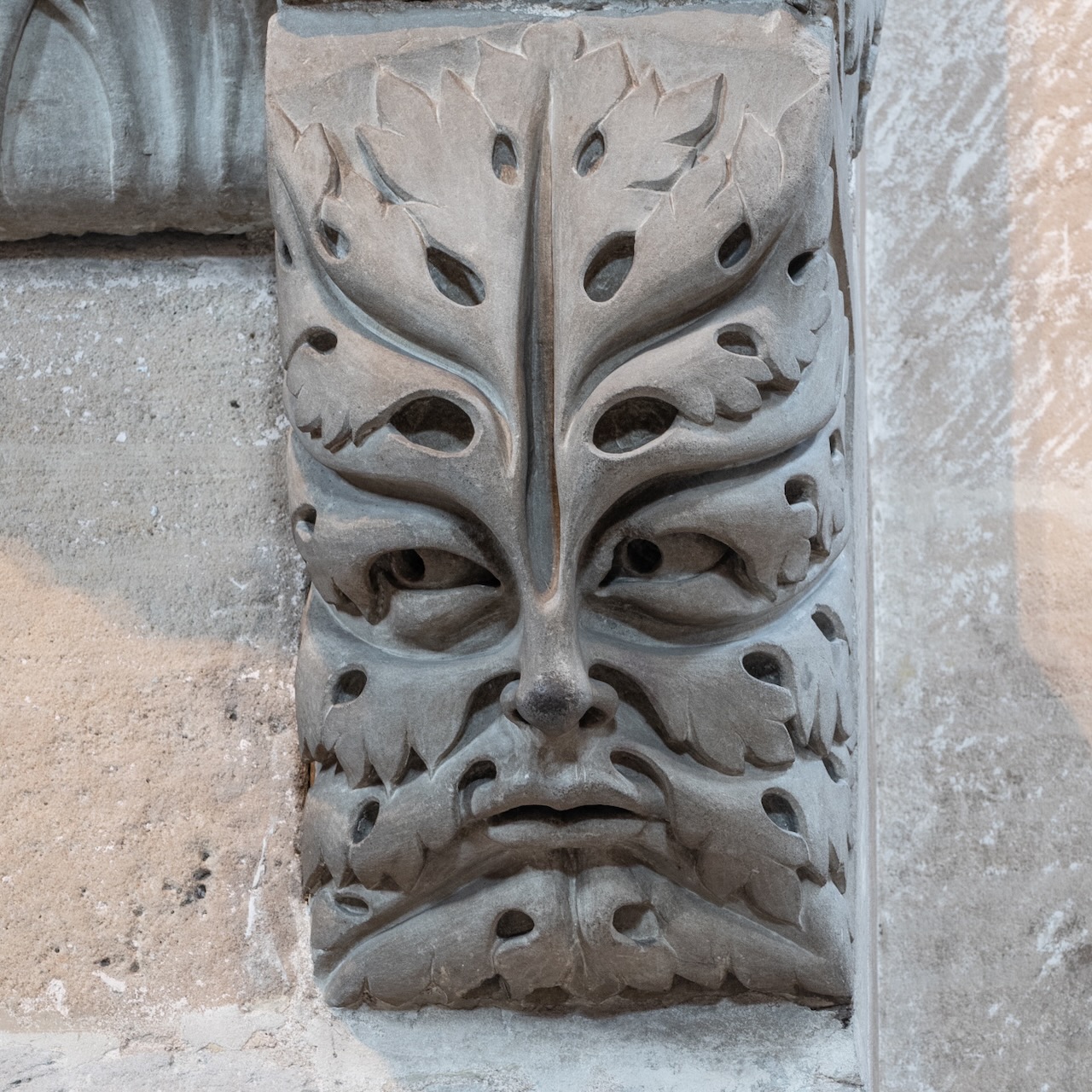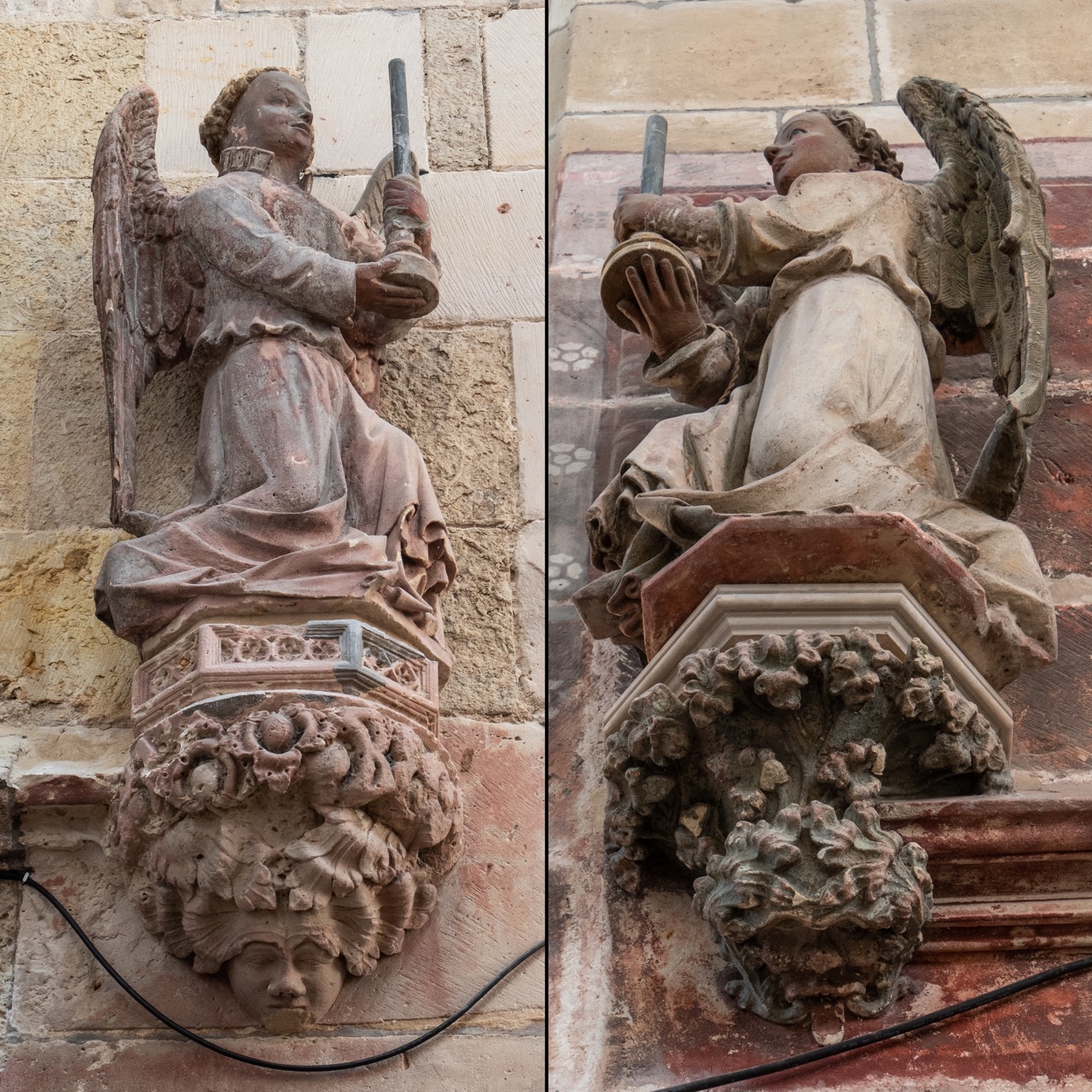The Term “Green Man”
As a sculptural element made of stone or wood, they are found in churches, mostly in Western Europe: Faces fused with leaves (fig. 1), sprouting plants from their mouths, noses, or eyes (fig. 2), or formed entirely of plant parts (fig. 3). In architectural and art historical contexts, the terms “foliate heads” or “foliate masks” are common for this. In Great Britain, these plant faces became known as “Green Man”, although not only men, but also, say, demons, cats and lions are depicted (fig. 4), and more often than not the faces are not even green (fig. 5).
In 1939, Lady Julia Raglan coined the phrase in her essay “The ‘Green Man’ in Church Architecture”: “It seemed to me certain that it was a man … and moreover that it was a ‘Green Man’. So I named it …” Not all of the foliate heads, but some, especially those decorated with oak leaves, would be so expressive that they could only be portraits of the central cult figure of some pagan spring sacrifices and May celebrations, known as “Green Man, Jack-in-the-Green, Robin Hood, the King of May, and the Garland.”
A Relic From Pagan Times?
Following Lady Raglan’s essay published in the journal “Folklore”, it became commonly accepted that the Green Men in churches were unofficial remnants of pre-Christian religions, the work of stonemasons or woodcarvers who adhered to some ancient cult of vegetation or fertility – silent acts of resistance against the dominating Christianity. Connections were constructed to pub signs and names (fig. 6a): In London alone, there are 30 pubs called “Green Man”.
The interpretation of the Green Man as a pagan-folkloristic motif took root quickly and spread from the second half of the 20th century onwards. Nikolaus Pevsner, an influential art and architecture historian who had emigrated from Nazi Germany to Great Britain, played a major role in this, using Raglan’s expression in his 46-volume series “The Buildings of England” (1951–1974). The Green Man became increasingly popular, whether as a symbol of a unity of man and nature – or as a beer label (fig. 6b).
A Christianized Motif!
Whatever the Green Man in churches may stand for, one thing can definitely be ruled out: They are not half-hidden secret signs of resistance of a pagan religion against a Christianity perceived as competition. Every church had to be consecrated by the respective bishop or his representative and they would certainly not have accepted symbols of other religions.
The Green Man has never been secret and hidden, as the sheer frequency of the motif, which has been used visibly in churches built between the 12th and 17th centuries all over Western Europe, speaks against it. Once you start looking for it, you will find countless examples that could not possibly have been overlooked for centuries by founders, builders, clergy and congregations or found offensive in any way. To the contrary, the Green Man is now used by church administrations as a vehicle for publicity and fundraising (Fig. 6c) and is sold in church souvenir shops: Contempt or embarrassed silence are certainly out of the question.
It is therefore a Christianised ornamental element and symbol which, like many others, found its way into the ecclesiastical pictorial cosmos and, depending on the time and place, was even very popular.
The Origins
The ancient foliate heads are known as the predecessors of the Green Men in medieval churches. After mythical creatures had already been composed of human, animal and plant parts in Hellenism, the actual foliate head emerged in Roman architecture in the second half of the first century CE. Along the Middle Rhine, for example at Mainz Cathedral in the framing of the arched field at the market portal (fig. 7), they are direct borrowings from provincial Roman monuments.
Another source may be Celtic, Celto-Roman or Anglo-Saxon representations of isolated heads in appropriate places (fig. 8), which were imitated and assigned a Christian meaning. The portals of Norwegian stave churches belong to this category (figs. 9, 10).
Christianity and church building did not come into being out of the blue, and from the very beginning they took up material found in the environment, including images and symbols, and gave them a Christian meaning – at the beginning of John's Gospel, therefore, there is talk of the divine Word becoming flesh: “The Word became flesh and dwelt among us” (John 1:14).
As an ornament, the ancient foliate head was often used for decoration. In the Christian context, it was first taken up in monastic book illumination and then soon also in Western church architecture and decoration. Illustrations in manuscripts, which were as highly respected as they were valuable, were an important source of inspiration for church founders, especially in France and Germany. It looks as if the Green Man motif thus found its way from book illustrations into church architecture. When the Normans conquered England in 1066, they brought it with them as a decorative as well as meaningful element (fig. 12).
During the Romanesque Period
Romanesque foliate heads often appear terrifying and evocative of demons (figs. 11 and 14), or they have the terrified expression of a human being tormented by demons (fig. 12): “The threat [of man] by demonic forces is often further emphasised when winding tendrils and leaves of ‘poisonous’ plants entangle and overgrow man. [At the same time] entwined or knotted ribbons have a repellent, banishing meaning. Evil is supposed to get entangled in them and have no passage. Ornamental, endless, often meandering ribbons can indicate eternity, depending on the design and context, in heaven as well as in hell" (Fichtl - fig. 13). Since the beginnings of Christianity, baptism marks the rejection of the devil and the beginning of a new life in the faith of the triune God - both can be symbolised on the baptismal font, including by means of the depiction of Green Men among other Christian symbols such as eagles and stags (fig. 14).
Already in the Romanesque period (fig. 15), but even more so in the Gothic period (fig. 16), plants sprout mainly from the mouth of the Green Man. This reminds of the words of Jesus, who speaks of evil coming out of the mouth and making man unclean, and in this context also refers to plants:
“It is not what goes into the mouth that defiles a person, but what comes out of the mouth; this defiles a person. … Every plant that my heavenly Father has not planted will be rooted up. … Do you not see that whatever goes into the mouth passes into the stomach and is expelled? But what comes out of the mouth proceeds from the heart, and this defiles a person. For out of the heart come evil thoughts, murder, adultery, sexual immorality, theft, false witness, slander. These are what defile a person..” (From Matthew 15:10–20)
During the Gothic Period
The expressive leaf mask on the console of the “Bamberg Horseman” from the first half of the 13th century belongs to the late Staufer period (fig. 17a). Its meaning is as enigmatic as that of the sculpture as a whole. One possible interpretation is that it is a symbolic representation of the different levels of the entire cosmos with their respective creatures. The leaf mask on the right below the plinth represents the underworld (fig. 17b); above it is the plant world indicated by the acanthus leaf, above that the animal world (horse), then man (horseman), and finally the canopy symbolising heaven.
In the Gothic period, the foliate heads appear preferentially as decoration of consoles (fig. 17c), capitals (fig. 18) and vaulting keystones (fig. 19) and also in the carvings on choir stalls (fig. 20). In these places they are not at eye level but at the edge, or in a serving position – either for statues of angels and saints (figs. 21a, 21b) or as leaning and sitting supports (misericordia) for the canons (fig. 22) or monks (fig. 23). They share this literally subordinate position with other representations of the forces of evil, which allows to draw conclusions about their interpretation: They are not in focus like biblical representations and saints, but form the framework and set the stage on which the story of salvation unfolds from the Word of God (figs. 7, 21).
In French art of the early 13th century, the most human-like and serene-looking form of the foliate head (fig. 24) emerges, which is already so widespread around 1235 that Villard de Honnecourt includes it in his “sketchbook”. The new form is also quickly taken up in German and English church building. The depictions of plants, which were still stylised in the Romanesque period, now become botanically definable – the individual plants are often symbols of certain qualities, virtues and vices. Examples are the black henbane to characterise the evil or demonic (fig. 26) and the oak leaf, representing loyalty and reliability (figs. 16, 25). But the embedding of human faces in leaves and plants can also generally point to the nature of man as a mortal being: “All flesh is like grass and all its glory like the flower of grass. The grass withers, and the flower falls, but the word of the Lord remains forever.” (Isaiah 40:6–8 / 1 Peter 1:24–25).
In the 16th and 17th Centuries
In the Renaissance, the face is then scarcely dissolved into plant form, but instead the classical-style mask is merely framed by foliage. The Reformation leads to a twofold response: The Protestant indifference towards or even rejection of images in churches, which goes as far as violent iconoclasm, is countered by the deliberate use of imagery, the richness of figures and the display of splendour in Catholic churches (fig. 27). There, the Green Man again plays a certain role in the 16th and 17th centuries: his grotesque, mask-like features become more prominent (fig. 28), even though these can already be found in the preceding epochs.
A comprehensive interpretation of the foliate heads in churches covering all epochs and places is not possible because, unlike many other Christian symbols (especially animals and plants), there are no written sources for them. However, the Green Men are an integral part of Christian iconography. Precisely because they remain enigmatic to this day (fig. 29), they are a constant source of amusement, amazement and meditation on the old question “What is man?”
TuK Bassler, August 2019
English version last updated 04/04/2022
Sources
Basford, Kathleen, The Green Man, D. S. Brewer, Rochester 1978
de Honnecourt, Villard, Sketchbook of Villard de Honnecourt (about 1230), MS. 19093 French Collection, Bibliothèque Nationale, Paris, http://gallica.bnf.fr/ark:/12148/btv1b10509412z.r=villard%20de%20honnecourt, retrieved 20/08/2019
Dinzelbacher, Peter: Köpfe und Masken. Spätmittelalterliche Bauplastik an mittelalterlichen Kirchen, Salzburg 2014
Fichtl, Friedemann, Der Teufel sitzt im Chorgestühl. Entdeckungen in alten Kirchen, Verlag am Eschbach, Eschbach 2009.
Greene King Brewing and Retailing Limited, https://www.greeneking-pubs.co.uk/discover/historic-pubs/the-green-man/, retrieved 09/05/2020
Hayman, Richard, The Green Man, Shire Publications, Oxford 2010
Jäger, Traugott, Von Steinen, die Dämonen abwehren, und von anderen, die predigen. Reliefs im Kloster Maulbronn - ihrer Bedeutung auf der Spur, Vaihingen/Enz 2001
Keller, Harald, Blattmaske, in: Reallexikon zur Deutschen Kunstgeschichte, Vol. II (1941), col. 867–874; in: RDK Labor, http://www.rdklabor.de/w/?oldid=88896, retrieved 14/08/2019
Livingstone, Josephine, The Remarkable Persistence Of The Green Man, The New Yorker, 07.03.2016, https://www.newyorker.com/books/page-turner/the-remarkable-persistence-of-the-green-man, retrieved 14/08/2019
Raglan, Julia, The “Green Man” in Church Architecture, Folklore, 50:1,45-57, https://doi.org/10.1080/0015587X.1939.9718148, retrieved 14/08/2019
Von Lüpke, Geseko, Der Grüne Mann – Eine verborgene Figur im Christentum, https://www1.wdr.de/radio/wdr5/sendungen/lebenszeichen/der-gruene-mann-100.html, retrieved 12/09/2022
Wikipedia, Bamberger Reiter, https://de.wikipedia.org/wiki/Bamberger_Reiter, retrieved 04/04/2024



































